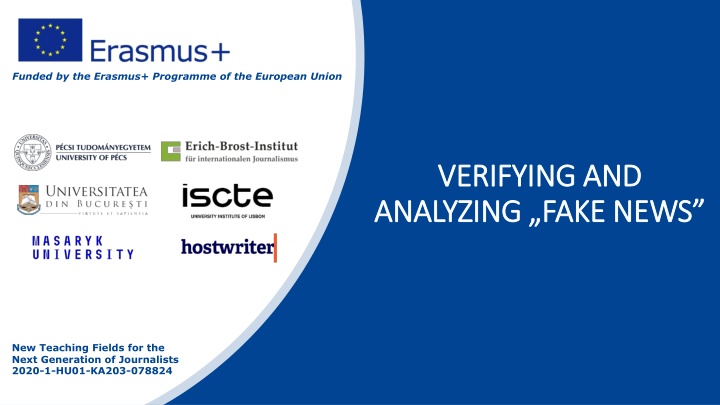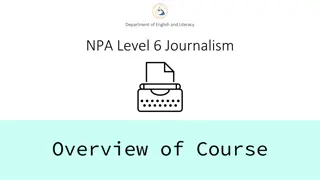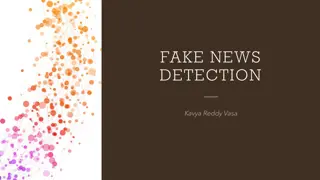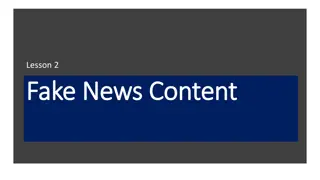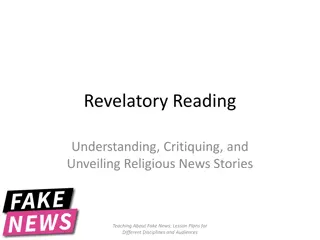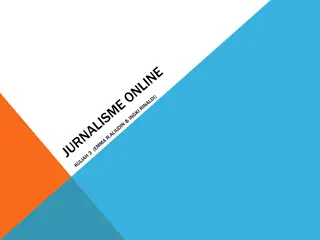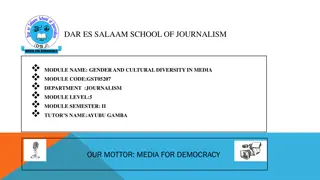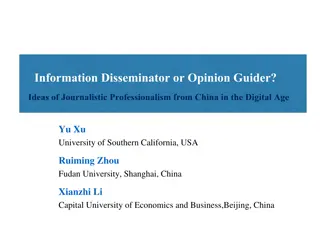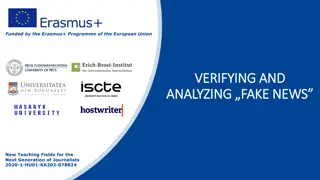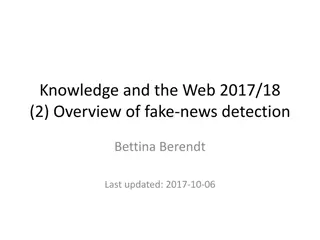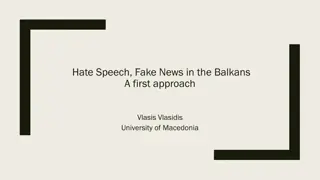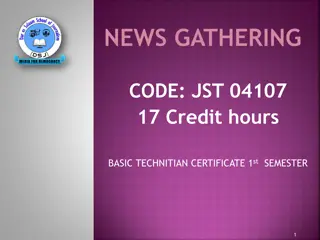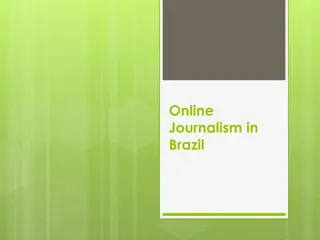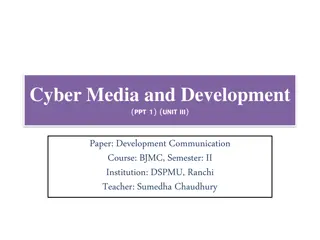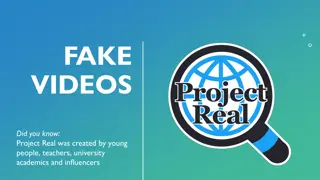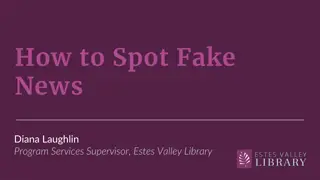Analyzing Fake News in Social Media - New Journalism Fields
The impact of social media on fake news dissemination, detection methods, and the importance of promoting news on social platforms. Discover why social media is a fertile ground for fake news and how to combat its spread effectively.
Download Presentation

Please find below an Image/Link to download the presentation.
The content on the website is provided AS IS for your information and personal use only. It may not be sold, licensed, or shared on other websites without obtaining consent from the author.If you encounter any issues during the download, it is possible that the publisher has removed the file from their server.
You are allowed to download the files provided on this website for personal or commercial use, subject to the condition that they are used lawfully. All files are the property of their respective owners.
The content on the website is provided AS IS for your information and personal use only. It may not be sold, licensed, or shared on other websites without obtaining consent from the author.
E N D
Presentation Transcript
Funded by the Erasmus+ Programme of the European Union VERIFYING AND VERIFYING AND ANALYZING FAKE NEWS ANALYZING FAKE NEWS New Teaching Fields for the Next Generation of Journalists 2020-1-HU01-KA203-078824
Lesson 3 - Fake news and social media
The Course Lesson 1 - Introduction of the course. History of Fake News Lesson 2 - What is the news? Fake news typology Lesson 3 - Fake news and social media Lesson 4 - Fact-checking
About the author Marian Popovici is a PhD student in Communication Studies and teaching assistant at the Faculty of Journalism and the Communications Sciences within the University of Bucharest. He is also a sport journalist. He is a graduate of both the Faculty of Journalism and Sciences (University of Bucharest) and the Faculty of Finance, Banks and Accounting (Dimitrie University). He also has two Thematic Journalism and Financial Banking Management. Communications Cantemir MA degrees: Photo source: personal archive of the author
What are we going to discuss? In this course we will find out why social media is such a fertile ground for fake news and how to detect fake news on social media Journalism is very present on social media and we will discuss about how important is the promotion of the news in social media for outlets Social media platforms started a few years ago to take actions in order to stop the spread of fake news
Social media and the spread of fake news According to statistics, 4,7 billion people around the world are using social media, which is a popular way to news consumption According to K. Shu et all, social media is also a fertile ground for disinformation and fake news: Because it has low barriers to provide and disseminate news online faster and easier through social media, disinformation such as fake news, those news articles with intentionally false information, are produced online for a variety of purposes, ranging from financial to political gains (2020, p. 2) large amounts of Photo source: Articulate Social media - fertile ground for fake news
News on websites vs. news on social media Edson Tandoc believes that the increasing number of people who get their news from social media instead of news websites leads to various consequences: Individuals judge a news story s credibility not only on who shared it on social media, but also on the number of likes, comments and shares. Fake news producers therefore often produce clickbait content to get more people to like, share, or comment on their fake stories, often playing into readers biases or interests'' (Jayakumar et. al., 2021, pp. 10-11) Social media - fertile ground for fake news
Example During the American elections in the USA in 2016, the fake news article named Pope Francis Shocks World, Endorses Donald Trump for President, Releases Statement had the biggest Facebook engagement. It surpassed every real news article about elections at this aspect, with over 960.000 reactions (likes, comments, shares), according to Buzzfeed https://www.linkedin.com/pulse/how-detect-fake-news-real-time-krishna- bharat?utm_source=share&utm_medium=member_android&utm_campaign=share_via Social media - fertile ground for fake news
The spread of fake news on social media It has a dynamic nature, can take various forms and disinformation can become misinformation, as K. Shu et al. explain (2020, p.3): For example, a disinformation creator can intentionally distribute the false information on social media platforms. People who see the information may be unaware that it is false and share it in their communities, using their own framing. On the other hand, misinformation can also be transformed into disinformation. For example, a piece of satire news may be intentionally distributed out of the context to mislead consumers . Social media - fertile ground for fake news
Disinformation trend, growing in the digital age There are several reasons why disinformation is growing in the digital age (Greifeneder et. al.2021, p. 29) Barriers to entry in news media have dropped significantly as websites can be easily set up and monetized via advertising The fixed costs associated with getting on social media are very small for fake news creators Photo source: Articulate Social media - fertile ground for fake news
Disinformation trend, growing in the digital age Social media are well suited to dissemination of fake news; the information tends to be distributed in short snippets of text There has been a continued decline in public trust and confidence in mainstream media In many western countries there has been a rise in political polarization and this can increase the likelihood of fake news being believed Social media - fertile ground for fake news
Controlling questions 1. A. B. C. What is the number of social media users globally in 2023? 1.5 billion people 4.7 billion people 7 billion people 2. Many individuals believe that the number of likes, comments and shares give more credibility to the news. True False 3. Which of the following is a reason for the growth of disinformation in social media? A. The majority of the real news outlets are on social media B. The users like to be entertained on social media C. Barriers to entry in news media have dropped significantly
Journalism on social media and the promotion of news
Social media and news consumption Vasterman (2018, p.313) exemplified how social media has changed news consumption: Imagine that there are two shops next to each other on a street and they sell the same product. In the first store, the patron sits inside and waits for customers to come and visit or buy something. The other patron is on the boulevard where everyone meets and sells some products there, talking to people and inviting them to come into the shop as well. We don't even have to think much about which of the two patrons are more successful in this case. Now, if the store represents the newspaper, the articles are the products and the boulevard is social media, it's no surprise that social networks are a very important part of this business". Journalism on social media
The fine line between news, fabricated content and fiction Ireton and Possetti (2018) believe that the line between news, entertainment, advertising, fabricated content and fiction is very blurred on social networks When disinformation is published, it is impossible to retract due to the massive distribution system, even if journalists or verification factors detect false information: The digital age has brought continuous, unprecedented challenges and industry changes to the news industry. Journalism is under pressure in the face of a virtual storm of pressures that feed informational dysfunction . Journalism on social media
Promoting the news in social media Social media became in the last years an important instrument to spread the news. The media outlets created specialized departments in order to maximize the potential of social media In this matter, there are some strategies that are used by media in order to attract more people from social media to news articles: Enhance the visual Create better and catchy titles Share the content in the right timeline Journalism on social media
Promoting the news in social media Share the content at the right platform for the targeted audience Post a strong information multiple times Pay for promotion Concentrate on mobile devices Photo source: Articulate Journalism on social media
Finding the truth on internet What can we do in order to find out if an article we read on the internet is true: Look at the source: it s a well known media outlet? It has a strange name? It is from a website with a stated political aim? Check it on the list of questionable or unreliable sources and websites Google it: an important news will be reported by several websites. If you find it on credible sources, there is a higher chance to be true Look after the evidence in the article: a well written news article will have strong evidence: documents, statements sources from well known Photo source: Articulate Journalism on social media
Controlling questions 1. On social media there is a fine line between news, fabricated content and fiction. True False 2. Which of the following is a strategy to promote news on social media? A. Post the information just once, for maximum impact B. Share the content at the right platform for the targeted audience C. Concentrate on desktop devices 3. A well written article doesn t need evidence in order to maximize the credibility. True False
Actions taken by social media platforms to stop fake news
How Facebook tackle fake news According to Statista, Facebook is the most popular social media network, with nearly 3 billion users in 2023, with a billion more than in 2016 In the last years, Facebook promised to tackle fake news in order to make the network a safer place and fight the spreading of false information The measures taken by Facebook to stop this scourge are: disrupting economic incentives, building new products to curb the spread of false news and helping people make more informed decisions. Social media platforms fighting fake news
Disrupting economic incentives Regarding disrupting economic incentives, Facebook has taken some steps into stopping the spammers to make money: better identifying false news through the community and third-party fact-checking organizations making it as difficult as possible for people posting false news to buy ads applying machine learning to assist the response teams in detecting fraud and updating detection of fake news accounts on Facebook, which makes spamming at scale much harder. Social media platforms fighting fake news
New products to limit the spread of fake news Facebook claims that they also build new products to limit the spread of fake news: Ranking improvements which includes feedback from the community Easier reporting and working with independent third-party fact- checking organizations Also, Facebook has two programs to help people make more informed decisions: Facebook Journalism Project News Integrity Initiative Social media platforms fighting fake news
On Facebook, the users can report by clicking on the three dots in the right of the post. There are several options for the report: Spam Nudity Unauthorized sales Violence Harassment Terrorism Hate speech False information Suicide or self-injury Example Social media platforms fighting fake news
Controlling questions 1. Facebook is the most popular social media network. True False 2. Identify one of the measures taken by Facebook to stop the spreading of fake news? A. Building new products to stop the spreading B. Limit the access for unverified accounts C. Making it easy for people posting false news to buy ads 3. Facebook has five programs to help people make more informed decisions. True False
Highlights Social media is a fertile ground for disinformation and fake news because it has low barriers to provide and disseminate news online faster and easier through social media The spread of fake news on social media can take various forms and disinformation can become misinformation The line between news, entertainment, advertising, fabricated content and fiction is very blurred on social networks Social media became in the last years an important instrument to spread the news. The media outlets created specialized departments in order to maximize the potential of social media The measures taken by Facebook to stop spreading of fake news are: disrupting economic incentives, building new products to curb the spread of false news and helping people make more informed decisions. Highlights
Bibliography, referred works Bharat, https://www.linkedin.com/pulse/how-detect-fake-news-real-time-krishna- bharat?utm_source=share&utm_medium=member_android&utm_campaign=share_via Barclay, Donald A. (2018): Fake News, Propaganda, and Plain Old Lies, The Rowman & Littlefield Publishing Group, London Data Reportal, 2022, Digital https://datareportal.com/reports/digital-2022-global-overview-report Greifeneder R., Jaff , M.E., Newman, E.J. , Schwarz N. (2021). The Psychology of fake news, Routledge Ireton C., Posetti J. (2018). Journalism, Fake News & Disinformation, UNESCO Series on Journalism Education, Paris Jayakumar S., Ang B., Anwar N. 2021. Disinformation and Fake News, Palgrave Macmillan, Singapore Meta for Media, Meta Journalism Project, https://www.facebook.com/formedia/mjp Krishna. (2017). How to Detect Fake News in Real-Time. 2022: Global Overview Report.
Bibliography, referred works Meta https://www.facebook.com/formedia/blog/introducing-the-news-integrity- initiative Meta for Media, Working to https://www.facebook.com/formedia/blog/working-to-stop-misinformation-and- false-news Shu, K. et al. (eds.) (2021). Disinformation, Misinformation, and Fake News in Social Media, Springer Silverman, C. (2016). This Analysis Shows How Viral Fake Election News Stories Outperformed Real https://www.buzzfeednews.com/article/craigsilverman/viral-fake-election-news- outperformed-real-news-on-facebook#.lkOvJO6p0 Vasterman, P. (coord.) (2018). From Media Hype to Twitter Storm. News Explosions and Their Impact on Issues, Crises, and Public Opinion. Amsterdam University Press for Media, Introducing the News Integrity Initiative, Stop Misinformation and False News. News On Facebook,
Sources of Photos Illustration pictures: Articulate Content Library 360 Unsplash: All photos published on Unsplash can be used for free. You can use them for commercian and non-commercial purposes. https://unsplash.com/license Pixabay: CCO 1.0 Universal (CC0 1.0) Public Domain Dedication http://www.pixabay.com
Sources of Photos Freepik: https://www.freepik.com/ Pexels: All photos on Pexels can be used for free. https://www.pexels.com Microsoft Powerpoint Stock Photos
Sources of Printscreens Bharat, Krishna. (2017). How to Detect Fake News in Real-Time. https://www.linkedin.com/pulse/how-detect-fake-news-real-time- krishna- bharat?utm_source=share&utm_medium=member_android&utm_ca mpaign=share_via
Where you can find us newsreel.pte.hu newsreel@pte.hu thenewsreelproject @thenewsreelproject The project was funded by the European Commission. The views expressed in this publication do not necessarily reflect those of the European Commission. @newsreelproject
